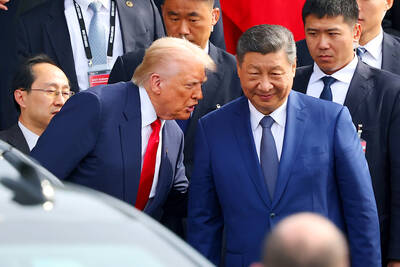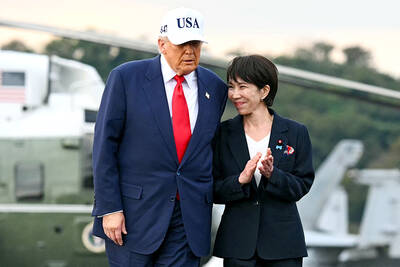The US recession has deepened, the US Federal Reserve said on Wednesday, as fresh data showed industrial output slumped to a decade low in March and annual inflation fell for the first time in 54 years.
“Overall economic activity contracted further or remained weak,” the Fed said in its Beige Book report, a survey of economic activity culled from the central bank’s 12 districts.
The report, based on information gathered from early last month until April 6, said five of the 12 districts surveyed noted a “moderation in the pace of decline” while several districts also “saw signs that activity in some sectors was stabilizing at a low level.”
The report did not provide figures on any additional economic contraction.
The latest government figures showed the economy contracted by 6.3 percent in the last quarter of last year, following a home-mortgage meltdown that triggered financial turmoil and slammed the brakes on economic growth.
The US plunged into recession in December 2007.
The government will announce its initial estimate of first-quarter GDP on April 29.
A survey of 53 economists released by the Wall Street Journal last week said GDP could contract in the first and second quarters of this year by 5 percent and 1.8 percent respectively.
A modest return to growth is not expected until the third quarter.
The Beige Book report, based on phone calls to businesses across the country, is used by the Federal Open Market Committee, the central bank’s policy-making body, in decision making. Its next meeting will be held on April 28 and April 29.
Policymakers last month voted to unanimously hold the Fed’s base interest rate at a historically low range of zero to 0.25 percent, where it has been since the middle of December and have suggested the rate would be kept there for quite some time.
Underscoring the depth of the US recession, government data showed on Wednesday that consumer prices last month posted their first annual drop in 54 years and industrial production fell to a decade low.
The Labor Department said the consumer price index (CPI) fell 0.1 percent last month on a seasonally adjusted basis from a month ago and declined 0.4 percent from a year ago, the first annual drop since August 1955.
Most analysts had expected a 0.1 percent month-on-month rise in March for the CPI, which tracks the average price of consumer goods and services purchased by households. It had risen 0.4 percent in February.
Core CPI, which excludes food and energy prices, increased 0.2 percent for the third month in a row in March. The core rate was up 1.8 percent from last March.
The annual inflation figure could continue to decline in the months ahead and “become significantly negative,” said Marie-Pierre Ripert, an economist with Natixis bank, adding that “the risk of deflation will not disappear rapidly.”
It could hit a negative 2.3 percent in July, as a result of a “large base effect” from oil prices that had reached record peaks above US$147 last year, she said.
Deflation is a price decline on a sustained basis that encourages consumers to delay purchases because they expect prices to continue falling.
The Fed said in a separate report on Wednesday that industrial production fell last month for the fifth consecutive month, by 1.5 percent, to the lowest level in a decade.
The seasonally adjusted monthly decline matched the 1.5 percent drop in February and was much steeper than the 0.9 percent decline expected by most analysts.
Output last month dropped to its lowest level since December 1998 and was a hefty 12.8 percent below its year-earlier level.
“The huge declines in industrial production in the past two quarters reflect very aggressive cuts in inventories by businesses,” said Nariman Behravesh, chief economist at IHS Global Insight.
“The potentially good news is that businesses are now close to getting their inventories under control,” Behravesh said.

UKRAINE, NVIDIA: The US leader said the subject of Russia’s war had come up ‘very strongly,’ while Jenson Huang was hoping that the conversation was good Chinese President Xi Jinping (習近平) and US President Donald Trump had differing takes following their meeting in Busan, South Korea, yesterday. Xi said that the two sides should complete follow-up work as soon as possible to deliver tangible results that would provide “peace of mind” to China, the US and the rest of the world, while Trump hailed the “great success” of the talks. The two discussed trade, including a deal to reduce tariffs slapped on China for its role in the fentanyl trade, as well as cooperation in ending the war in Ukraine, among other issues, but they did not mention

Japanese Prime Minister Sanae Takaichi yesterday lavished US President Donald Trump with praise and vows of a “golden age” of ties on his visit to Tokyo, before inking a deal with Washington aimed at securing critical minerals. Takaichi — Japan’s first female prime minister — pulled out all the stops for Trump in her opening test on the international stage and even announced that she would nominate him for a Nobel Peace Prize, the White House said. Trump has become increasingly focused on the Nobel since his return to power in January and claims to have ended several conflicts around the world,

CALL FOR SUPPORT: President William Lai called on lawmakers across party lines to ensure the livelihood of Taiwanese and that national security is protected President William Lai (賴清德) yesterday called for bipartisan support for Taiwan’s investment in self-defense capabilities at the christening and launch of two coast guard vessels at CSBC Corp, Taiwan’s (台灣國際造船) shipyard in Kaohsiung. The Taipei (台北) is the fourth and final ship of the Chiayi-class offshore patrol vessels, and the Siraya (西拉雅) is the Coast Guard Administration’s (CGA) first-ever ocean patrol vessel, the government said. The Taipei is the fourth and final ship of the Chiayi-class offshore patrol vessels with a displacement of about 4,000 tonnes, Lai said. This ship class was ordered as a result of former president Tsai Ing-wen’s (蔡英文) 2018

GLOBAL PROJECT: Underseas cables ‘are the nervous system of democratic connectivity,’ which is under stress, Member of the European Parliament Rihards Kols said The government yesterday launched an initiative to promote global cooperation on improved security of undersea cables, following reported disruptions of such cables near Taiwan and around the world. The Management Initiative on International Undersea Cables aims to “bring together stakeholders, align standards, promote best practices and turn shared concerns into beneficial cooperation,” Minister of Foreign Affairs Lin Chia-lung (林佳龍) said at a seminar in Taipei. The project would be known as “RISK,” an acronym for risk mitigation, information sharing, systemic reform and knowledge building, he said at the seminar, titled “Taiwan-Europe Subsea Cable Security Cooperation Forum.” Taiwan sits at a vital junction on